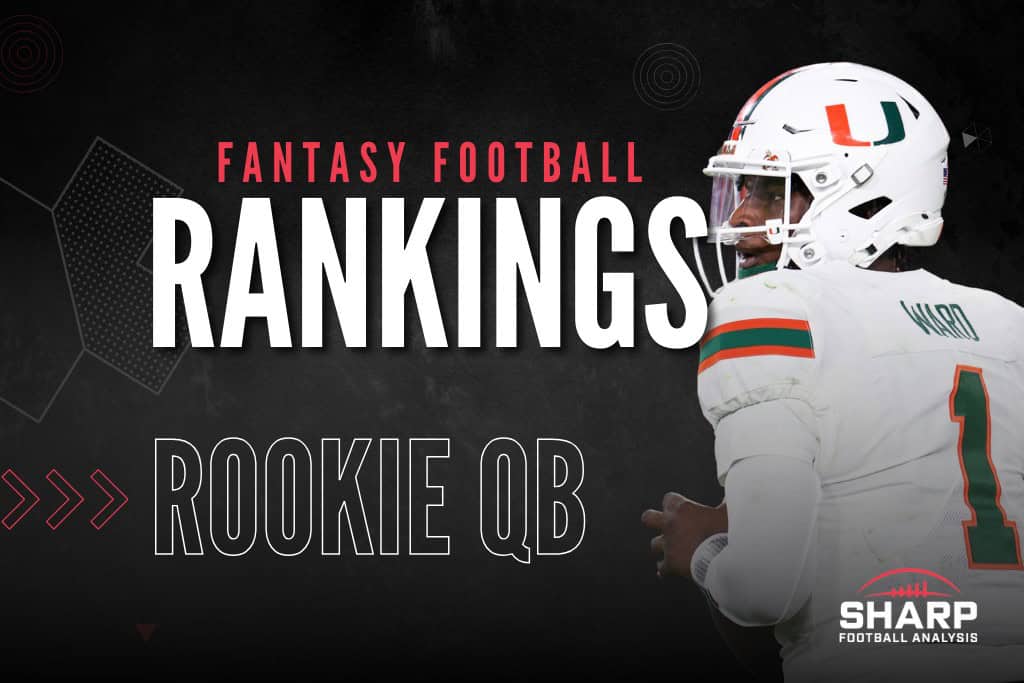Exiting the NFL Combine, let's dig into the incoming rookie class for Dynasty rookie drafts, startup drafts, and these young players' potential in 2025 seasonal formats.
Even before the NFL Draft in April, rookies are available in Best Ball formats across all platforms.
| 2025 Dynasty Rookie Profiles |
|---|
| Rookie Quarterback Profiles |
| Rookie Running Back Profiles |
| Rookie Wide Receiver Profiles |
| Rookie Tight End Profiles |
Now that the NFL Combine has passed, we have a plethora of new athletic data on this upcoming rookie class.
That information can be applied to athletic models and used to shape complete portfolios and production profiles, a general overlay of what these players put on tape for NFL teams.
We are kicking things off with the quarterbacks.
The quarterback position has the most significant difference between viewed success and fantasy success.
Scouting and analyzing how collegiate passers will translate to the next NFL has been an ongoing battle with more losses than wins.
The good news is that we are not selecting these passers with the inherent real-life ramifications that an NFL franchise has when a player evaluation is missed.
We also have the benefit of knowing which quarterback archetypes can access fantasy upside and adjust accordingly.
This class does not have a wealth of mobility paired with passing production.
With SuperFlex and 2QB formats rising in popularity to add relevancy to the position, the top of the position has become more pertinent to invest in Dynasty rookie drafts.
Those formats boost quarterbacks who could have floor capability.
However, that bucket of passers who rely on passing production as their only way to create fantasy points has minimal value. It is mainly replaceable in formats requiring you to start one player at the position.
While continuing to grow, until formats that entail multiple starting quarterbacks become the industry standard, the quarterback position remains a supply-and-demand game that favors suppressing incoming rookies since so many fantasy leagues are still starting one quarterback.
Post-draft, we will have the influence of draft investment and landing spot to add to the layout.
You can find previous versions of this post from the 2020, 2021, 2022, 2023, and 2024 seasons through these links.
Contents
Don't Miss Out on The Best Fantasy Football Coverage in the Business
Like the NFL, fantasy football never sleeps.
From rankings to the best draft strategies, Sharp Football has everything you need to get ready for the fantasy season in our Fantasy Football Draft Kit, powered by premier fantasy football analyst Rich Hribar.
Save more by bundling the Draft Kit with our in-season fantasy package that features Rich's comprehensive “Worksheet” preview of every game, every week of the NFL season.
Click here for more information about our fantasy coverage!
Tier 1 Dynasty Rookie Quarterbacks
This quarterback class follows one of the strongest the position has had in the 2000s, one that essentially delivered on the initial investment for the league and fantasy gamers.
Jayden Daniels and Bo Nix had excellent rookie seasons.
Caleb Williams, Drake Maye, and Michael Penix gave gamers things to help them feel good about moving forward.
We did not see J.J. McCarthy play in 2024 due to a knee injury, but the 2024 draft class started strongly overall.
The top of the 2025 quarterback class does not have the same confidence levels as last season’s class, dampening the excitement for some.
Still, this is a solid opening tier of prospects.
There are some red flags with the prospects in this class but also plenty of positives.
I do not believe anyone here will challenge Daniels' first-year fantasy production as a rookie.
Still, all three quarterbacks in this tier objectively grade out better or similar to the secondary tier of passers from a year ago in my model.
All have marks in that same area as Maye, Penix, Nix, and McCarthy, who all ended up as front-end draft picks in the NFL.
That is where I start my expectations for this draft class.
We do not have a high probability of finding front-end QB1 fantasy stars here.
Instead, I am looking at the top of this class as providing usable QB2 performers who can moonlight as QB1 scorers in a given season when things line up.
Cam Ward, Miami
Final Year Age: 22.6
Ward is projected to be the first passer selected in this class, and my prospect model also has him in front.
I wish we had a larger sample of Ward facing front-end caliber competition, but the passing resume is strong.
After spending two seasons at Washington State, Ward threw 39 touchdown passes with 7 interceptions at Miami this past season.
After averaging 6.5 and 7.7 yards per pass attempt in his first two seasons, he spiked to 9.5 yards per pass attempt this year.
51.1% of his passes resulted in a first down or touchdowns, the highest rate of this class.
Ward closed his collegiate career with a passing production grade in the 90th percentile among passers invited to the Combine in the 2000s.
Ward has a gunslinger mindset, and scouts suggest he will need to be reined in at the next level.
There is merit to that under the proper context.
You often will hear him compared to Jameis Winston, who was much more reckless with the football overall than Ward in college, something that bled into Winston’s NFL portfolio.
The stickiest areas for collegiate production carrying over to the NFL are accuracy, turnovers, and sacks taken.
A player like Winston had red flags in those areas, closing his collegiate career with a TD-to-interception ratio in the 8th percentile among passers in their final season.
His completion rate in his final season was in the 59th percentile.
Ward has posted an interception rate below 2% in all three seasons as a starter.
Throwing 5.6 touchdowns for every interception this season, he ranks in the 87th percentile for final season production in that department and the 85th percentile for his collegiate career.
His final season completion rate was in the 73rd percentile, and he ranked in the 78th percentile for his career.
That said, there was some fortune for Ward under pressure while he was at his best in the pocket, so you hear some of the concerns when he goes into “hero mode.”
According to Pro Football Focus, Ward's 7.5% turnover-worthy play rate when pressured was the highest of this draft class.
Even though he protected the ball overall, his mistakes came when pressured.
His 54% on-target rate on throws outside the pocket was the lowest in this draft class this past season while his 5.8% interception rate outside the pocket was the highest.
He loves to extend plays.
Averaging 2.93 seconds from the snap to throw this past season, his time to throw was the second-longest of any quarterback in this class.
Ward did not take a ton of sacks despite holding the football, at least.
His 4.5% sack rate was average for this class.
18.9% of Ward’s pressures were credited as his fault for holding the ball per Pro Football Focus, but he only took two sacks on those 21 pressures credited as his fault.
That 9.5% sack rate on self-induced pressure was the lowest of this draft class this past season.
Ward inherently wants to push the ball downfield, so he is prone to holding it. His holding the ball did not result in many self-induced sacks, which was positive.
This was an issue for Caleb Williams entering the league last season, and it plagued his rookie season.
It is the most significant difference between Ward and Shedeur Sanders at the top of this class, and we will discuss it shortly regarding the latter.
Ward was successful when he pushed the ball downfield.
He threw the second-highest rate of passes 10 or more yards downfield, completing 58.7% of his passes 10 or more yards downfield. That was second in this class.
Will Howard completed 61% but also attempted 38 fewer of those passes despite playing in three more games than Ward.
18.9% of his throws of 20 or more yards downfield were touchdown passes, second in this class.
Against the blitz, Ward completed 69.5% of his passes (third) while 51.2% of his passes when blitzed resulted in a first down or touchdown (second).
49.9% of Ward’s passes from a clean pocket went for a first down or touchdown, the highest rate in the class.
His 10.1 yards per pass attempt average from a clean pocket was second.
Ward did not have inflated production due to the scheme.
Only 10.8% of his yardage came on screen passes, ninth in the class.
29.4% of his dropbacks came with play-action, eighth in the class.
He led the class with 9.8 yards per pass attempt on non-play-action passes.
Removing all of the easy buttons (play action, pre-snap motion, RPO, and screens), Ward led the class with 11.2 yards per attempt.
Where Ward did run into issues was in the red zone with a condensed field.
He completed 53.9% of his passes in the red zone this past season, the second-lowest rate in this class.
His rushing production will likely come with week-to-week variance in the NFL, but he can provide rushing output as a bonus for fantasy points.
Ward ended his career with a rushing profile in the 63rd percentile.
His rushing production was nearly entirely built on scrambles versus designed rushing usage, so I suggest it will come with a weekly variance.
Ward only had four designed runs last season.
Shedeur Sanders, Colorado
Final Year Age: 22.9
Sanders has added hype to his brand because he is the son of Deion, but his anticipated draft capital is a product of his performance.
Sanders enters the NFL with career passing production in the 93rd percentile.
He is in the 98th percentile in career completion rate (70.1%) and ranks in the 93rd percentile in career TD-to-INT rate (5.0%).
Where Sanders does have added concerns compared to Ward and Jaxson Dart at the top of this class is that the latter two steadily improved and closed this past season on a higher note while Sanders dipped a touch in his second season at Colorado compared to 2023.
Ward's and Dart's final-season passing production was in the 90th percentile or higher. Sanders' was in the 80th percentile.
That is still solid, but the final-season output has been a more significant signal entering the NFL if you want to split hairs at the top.
His 74% completion rate is in the 98th percentile for final-season output for prospects since 2000, but his 8.7 Y/A is in the 68th percentile while the 3.7 TD-to-INT rate is in the 62nd percentile.
Sanders is at his best when he works within the offense and stays on schedule.
He is another prospect who will hold the ball, but he is consistently accurate when he has a clean pocket and plays in the rhythm of the offense with anticipation.
He provides his playmakers with opportunities to create after the catch.
He does not have the raw arm talent that Cam Ward has, but he can compensate when he is playing within the natural ebb and flow of the offense.
Sanders averaged a class-high 3.0 seconds from the snap per throw this past season.
But from a clean pocket, he averaged 2.35 seconds to throw the football, the sixth-fastest rate in this class.
Sanders completed a class-high 80.8% of his passes from a clean pocket in 2024.
24.1% of his passes came at or behind the line of scrimmage (the third-highest rate in this class).
15.3% of his passing yardage came on screens, the second-highest rate in the class.
But Sanders also had a 69.5% on-target rate on his throws 10 or more yards downfield, which was second in this class.
The Colorado offense had a high rate of screens built into its scheme, which did propel Sanders' completion rate.
However, even with that element baked in, 47.6% of Sanders’s pass attempts came without play action, motion, an RPO component, or screens, the highest rate in this draft class.
On those plays, he completed 70.3% of his passes (third in the class) for 10.6 Y/A (4th), and a 9.6% touchdown rate (2nd).
Sanders can create on his own, resetting pockets and buying time, but that is also the part of his game that creates the problems he encounters.
Sanders only had a 1.3% rate of turnover-worthy throws this past season (second lowest in the class), but he also took a class-high 7.3% sack rate.
He was sacked on a class-high 7.5% of his third and fourth down dropbacks.
We discussed this with Caleb Williams before he entered the NFL, and we saw it remain static in his rookie season.
Sure, he wasn’t turning the ball over directly via interceptions, but he was taking a lot of sacks, which are adjacent to turnovers in the NFL.
Colorado’s offensive line was a significant issue in both seasons, but Sanders invites pressure at the highest rate of any quarterback in this class.
Sanders had the highest pressure rate of any quarterback in this draft class, 36.2% of his dropbacks in 2024.
He handled pressure well, completing 55.1% of his passes (3rd) for 8.1 Y/A (5th) when pressured.
According to Pro Football Focus, 26.2% of his pressures were credited as his fault, the highest rate of this class.
His time to throw when pressured was 4.14 seconds after the snap.
He took a class-high 17 sacks on pressures that he was credited with creating.
As noted above, Ward only took two of those sacks.
This is where the landing spot comes into added importance for Sanders entering the league.
Pat Shurmur put Sanders in an offense that you can argue made decision-making easier for him, but you also see the upside, and he had played within that structure.
If Sanders is in a position to pushes him to do a lot of his own work, that type of environment can stall his progression in his early career.
Sanders can tack on rushing production, but his rushing output will be inconsistent weekly since scrambles will drive it.
Sanders ended his collegiate career with a 50th-percentile rushing score.
His 6.9% scramble rate was third in this draft class, but only 7 of his runs were designed attempts.
Jaxson Dart, Ole Miss
Final Year Age: 21.6
Ward and Sanders are solid bets to start Week 1 of the 2025 season.
The rest of this class does not share the same probability.
Dart’s draft capital could be higher or lower than expected, which adds some volatility to his initial fantasy stock, but he belongs in this group.
My prospect model also has Dart with a slightly higher top-down grade than Shedeur Sanders.
If he can surprise and push the expected draft capital that Sanders receives, then Dart will be someone who pushes for QB2 in this class in post-draft rankings.
Dart improved his completion rate and yards per pass attempt every season in college, ending his career at Ole Miss with a 69.3% completion rate (85th percentile), 10.8 Y/A (97th percentile), and 4.8 touchdowns for every interception (81st percentile).
Dart led this draft class in yards per pass attempt under pressure (10.2 Y/A) and with a clean pocket (10.9 Y/A).
Dart is slightly younger than Ward and Sanders but still more battle-tested, starting in the SEC over the past three seasons.
The questions for Dart stem from that, as well.
He played with better surrounding talent, and several quarterbacks have posted gaudy collegiate production under Lane Kiffin.
The interesting part for Dart compared to his predecessor is that while Matt Corral had inflated efficiency via the quick game, Dart pushed the rock downfield and looked to “big game hunt” via explosive passing.
Dart had the highest depth of target for any passer in this draft class (11.9 yards downfield).
Only 55.4% of his throws were shorter than 10 yards downfield, the lowest rate in this class.
22.1% of his throws were 20 yards or further downfield, the highest rate in the class by a significant margin (second place was 17.6%).
Dart was strong on his downfield attempts, posting a class-high 70.9% on-target rate on his throws 10 yards or further.
He led this draft class with a 7.1% big-time throw rate, according to Pro Football Focus, the company's metric for successful passes thrown downfield into tighter windows.
Dart led this class with 11.9 yards per pass attempt against the blitz.
Dart’s 83.7% on-target rate in the red zone was second in the class, and he only took 1 sack on 50 red zone dropbacks with 0 interceptions.
The continued progression of Dart is an encouraging aspect of his entering the league.
At the same time, his system attachment will raise the most significant questions if he is in a tougher offensive environment at the start of his NFL career.
Only 26.6% of his passes were made without using play-action, motion, or screens, the fourth-lowest rate in this class.
53.2% of his dropbacks came with play-action, the highest rate of this class.
Those components are cheat codes in the NFL, and we want our quarterbacks to use them at a high rate as Dart did in college, but what happens if he ends up in an offense that does not incorporate them?
A positive is that he averaged 10.7 Y/A on his traditional dropbacks without any of those additions.
Still, the current NFL passing game dictated by how NFL pass defenses are playing is structured around the quick passing game while Dart’s collegiate profile is built on the opposite.
That is what makes his translation into the NFL tricky to handle.
Dart is another passer here who will rely on scrambling over designed rushing output in the NFL, but he can get out of trouble and showed a more significant propensity to run than Ward and Sanders did in college.
Dart has a career rushing production score in the 72nd percentile.
He scrambled on 9.5% of his dropbacks, the second-highest rate in this draft class.
When pressured, Dart scrambled on 19.2% of his dropbacks (also second).
Tier 2 Dynasty Rookie Quarterbacks
After the opening tier of passers, we are in no-man’s land with this draft class.
The opening three quarterbacks should all compete to start as early as Week 1 this upcoming season, but the rest of this class will need doors opened for them to a degree.
It would not be surprising to see only the players in the opening tier selected in 1QB formats.
This following subset of quarterbacks will draw intrigue when added to 2QB rosters, but the depth of the running back and wide receiver positions in this class makes it harder to make those types of swings this season.
Unless we see a player here greatly surpass his expected draft capital or land a spot to compete for snaps on a roster with significant quarterback need, I will largely avoid the rest of this draft class in rookie drafts in all formats.
Jalen Milroe, Alabama
Final Year Age: 22.1
Milroe may not be the best secondary quarterback for an NFL team to take a shot on.
But if we are talking about fantasy football relevancy for this group – when (if) they do make starts in the league – Milroe's rushing ability will immediately make him a viable fantasy asset.
He is a throwback Konami quarterback built on a front-end rushing ceiling.
He closed his career out with a 94th-percentile mark in rushing production.
Milroe rushed for 33 touchdowns (20 this past season).
He had 94 designed runs this past season, the most in this draft class.
His athleticism and big arm will make him an intoxicating project for a team to take on as a traits-based developmental player.
Still, Milroe’s passing production makes him a project and could prevent him from a sustained run as a starting NFL quarterback.
Milroe has a 20th percentile passing grade entering the league.
He did average 9.1 yards per pass attempt for his career (second in this draft class), but he also completed only 64.3% of his passes (10th) with a 2.3 TD-to-INT rate (14th).
This past season, Milroe threw 1.5 touchdowns per interception, the worst rate in this class.
Over his final 9 games, Milroe threw 6 touchdowns with 10 interceptions.
37.9% of his passes resulted in a first down or touchdown, the second-lowest rate of this class.
He was blitzed at the highest rate in this class (41.2%) and had the lowest completion rate (57.6%) against the blitz.
Milroe completed a class-low 50% of his passes in the red zone with a class-high 10.7% interception rate.
Milroe also was at his worst when tasked to punch up with the competition.
Against Power-5 opponents, Milroe had a 3.4% touchdown rate (second to last) with a class-high 4.1% interception rate.
Milroe is the archetype of a quarterback to nibble on with cheap capital in 2QB formats if you want to make swings on a player immensely outperforming his initial draft value.
Will Howard, Ohio State
Final Year Age: 23.3
Howard ended his college career with career-best marks in completion rate (73%), yards per attempt (9.5 Y/A), and passing touchdowns (35), transferring to Ohio State after four seasons with Kansas State.
Howard boosted his draft stock by playing his best football on the stage where it mattered the most, which will surely help his draft stock with interested parties.
In four postseason games, Howard completed 75.2% of his passes for 10.6 Y/A with 8 touchdowns and 2 interceptions.
Howard has the throwback size (6-foot-4 and 236 pounds) that not many quarterbacks in this class have, something old-school scouts will like.
He completed a class-high 73.2% of his passes against the blitz while posting the highest big-time throw rate (36.4%) per Pro Football Focus on throws 20 or more yards downfield.
Howard was only sacked on 12.2% of his pressures (second in the class).
The questions for Howard will be how much elevation he received playing alongside the surrounding talent at Ohio State compared to his limited production attached to a weaker surrounding cast at Kansas State.
Even with his 2024 production factored in, Howard carries a 60th percentile completion rate (63.8%), 59th percentile yards per pass attempt (8.2), and a 40th percentile TD-to-INT rate (2.4) for his career.
Quinn Ewers, Texas
Final Year Age: 21.8
Another player in the Ohio State pipeline at some point, Ewers transferred to Texas in 2022, where he made 36 starts for the Longhorns over the past three seasons.
After posting career-best efficiency in 2023, Ewers took a step back this past season.
He completed 65.8% of his passes after 69% in 2023.
He averaged 7.8 yards per attempt after 8.8 in 2023.
His interception rate climbed to 2.7% after a 1.5% rate in 2023.
He did post a higher touchdown rate (6.9%) this past season than in 2023 (5.6%) as a silver lining.
Ewers had more manufactured for him than any quarterback in this class last season.
Only 16.4% of his passes came without play action, motion, or on screens, the lowest rate in this class.
28.2% of his throws were at or behind the line of scrimmage, the highest rate in this class.
Despite that, he had the highest turnover-worthy throw rate (4%) in this class.
Ewers played through most of the season with an oblique injury to generate a pass to a degree.
While it is fair to factor in that injury, the impact is hard to quantify because he was still playing.
The NFL Draft process has tactics to play up.
If he and his camp play up that injury, they only need one team to believe it.
Not much changed in terms of how Ewers was operating through the injury.
He threw 26.9% of his passes at or behind the line in 2023, just below his rate this past season.
His deep target rate increased in 2024 (12.9%) from 2023 (11.9%).
Even if you are stocking more of his production from 2023 being the norm, there is plenty of guesswork with Ewers as a future NFL starter, and he does not come with rushing upside.
Kyle McCord, Syracuse
Final Year Age: 22.3
McCord propelled himself into the draft fold by transferring to Syracuse from Ohio State, helming an offense that allowed him to stack production.
No quarterback in this draft class had more dropbacks last season than McCord (640), 77 more than the next closest player in this draft.
McCord had the fastest time to throw in this draft class (2.4 seconds) despite throwing the lowest rate of passes at or behind the line of scrimmage (12.5%).
McCord is an interesting case study this offseason.
He underperformed his surrounding talent at Ohio State and outperformed his surrounding talent at Syracuse.
Nothing stands out as unique in profile for fantasy output.
He had solid counting stats pumped up by a high number of dropbacks, but among prospects in their final seasons, he only managed 8.1 yards per pass attempt (47th percentile) and 2.8 touchdowns per interception (46th percentile).
His 68.7% completion percentage from a clean pocket was the second-lowest of this draft class.
His 3% turnover-worthy throw rate from a clean pocket ranked 13th out of 15 passers invited to the Combine.
A pure dropback passer, McCord only scrambled on 2.3% of his dropbacks, the lowest rate in this class.
Tyler Shough, Louisville
Final Year Age: 25.3
Shough has had one of the odder rides for any quarterback prospect to enter the league, let alone this draft class.
Shough was in the 2018 recruitment class, alongside Trevor Lawrence, who has already logged four NFL seasons.
Shough backed up Justin Herbert at Oregon for two seasons to open his career.
He floundered in his first season as a starter at Oregon in 2020 before transferring to Texas Tech, where he had no luck staying on the field.
Shough broke his left collarbone in 2021, re-broke that collarbone in 2022, and then broke his fibula in 2023.
He transferred to Louisville this past season, giving him 7 years of college experience.
Shough had not appeared in more than 7 games in any season before 2024 but stayed on the field this past season, completing 62.7% of his passes for 3,195 yards (8.2 Y/A) with 23 touchdowns and 6 interceptions.
Shough has picked up some steam early in the draft process, which makes him someone to keep an eye on where he is selected.
This season, he was sacked on a class-low 3.3% of his dropbacks and only had a 1.8% turnover-worthy rate on his throws (fourth), but the rest of the things make it harder to gauge.
Through his journey filled with transfers and injuries, Shough will be a 26-year-old rookie.
However, unlike guys like Bo Nix and Jayden Daniels last season, who were also older, Shough does not have the same type of on-field experience, which will be reflected in his draft capital.
Despite seven years in college, Shough has only 951 career pass attempts.
Only Milroe (663) has fewer in this class.
The on-field sample is also sketchy when looking under the hood.
Against Power-5 opponents, Shough’s 70% on-target rate was the second lowest in this class.
When blitzed, he completed 58.4% of his passes, ahead of only Milroe.
He completed 42.3% of his passes when pressured, ahead of only Max Brosmer in this class.
Shough pushed the rock when kept clean.
He averaged 9.2 air yards per attempt (5th) from a clean pocket and a class-best 0.3% turnover-worthy play rate.
Protecting the football and avoiding sacks can keep an offense on track, which gives Shough a pulse while navigating his injury history and the journey to this point.
Tier 3 Dynasty Rookie Quarterbacks
- Dillon Gabriel, Oregon – Final Year Age: 24.0
- Riley Leonard, Notre Dame – Final Year Age: 22.3
- Seth Henigan, Memphis – Final Year Age: 21.8
- Kurtis Rourke, Indiana – Final Year Age: 24.2
- Brady Cook, Missouri – Final Year Age: 23.2
- Max Brosmer, Minnesota – Final Year Age: 23.8
- Graham Mertz, Florida – Final Year Age: 24.1
This is the back end of the position.
None of these quarterbacks are expected to be drafted until Day 3, which makes them extremely tough bets in rookie drafts.
There will be players here who will inevitably start games, but we are not projected sustainable starters in this range.
Dillon Gabriel is the most decorated player in this group.
Gabriel has appeared in 64 games over six collegiate seasons at UCF, Oklahoma, and Oregon.
He is one of only seven quarterbacks invited to the NFL Combine with over 2,000 career pass attempts.
Only three quarterbacks have thrown more passes than Gabriel entering the NFL, but that is also a problem since he never carried enough cache to jump from college to the pros.
Gabriel is undersized (5-foot-11 and 205 pounds) as the main hindrance.
He also was more of a bus driver, posting the lowest target depth (7.0 air yards) with the lowest big-time throw rate (3.2%) in this class.
17.0% of his passing yards came via screen passes, the highest rate of any passer here.
Still, he is an effective scrambler with experience, which will get him drafted.
If Riley Leonard ever gets a shot to play in the NFL, his mobility will give him an immediate fantasy upside.
He has a 93rd-percentile career rushing production grade.
Leonard rushed for more yards per game (49.5 yards) than any quarterback in this class over his career.
Only Milroe had more designed runs than Leonard this past season.
Kurtis Rourke is a wild card here at the bottom.
He played the season with an ACL injury that may impact his draft status, but he has enough prototype size (6-foot-4 and 220 pounds) and overall production to keep the lights on.
Rourke started double-digit games over his final four seasons at Ohio and Indiana, ending with strong marks in 2024.
He has a career 86th-percentile completion rate (67%), 84th-percentile TD-to-INT rate (3.8), and 69th-percentile yards per pass attempt (8.3).
Rourke played in friendly conditions, facing the lowest pressure rate (20.8%) of any quarterback in this class last season, but he took a sack on a class-high 26.7% of his pressures.
2025 Dynasty Rookie Quarterback Rankings
| Rank | Player | College | FY Age | Tier |
|---|---|---|---|---|
| 1 | Cam Ward | Miami | 22.6 | 1 |
| 2 | Shedeur Sanders | Colorado | 22.9 | 1 |
| 3 | Jaxson Dart | Mississippi | 21.6 | 1 |
| 4 | Jalen Milroe | Alabama | 22.1 | 2 |
| 5 | Will Howard | Ohio State | 23.3 | 2 |
| 6 | Quinn Ewers | Texas | 21.8 | 2 |
| 7 | Kyle McCord | Syracuse | 22.3 | 2 |
| 8 | Tyler Shough | Louisville | 25.3 | 2 |
| 9 | Riley Leonard | Notre Dame | 22.3 | 3 |
| 10 | Dillon Gabriel | Oregon | 24.0 | 3 |
| 11 | Kurtis Rourke | Indiana | 24.2 | 3 |
| 12 | Max Brosmer | Minnesota | 23.8 | 3 |
| 13 | Seth Henigan | Memphis | 21.8 | 3 |
| 14 | Brady Cook | Missouri | 23.2 | 3 |
| 15 | Graham Mertz | Florida | 24.1 | 3 |

















